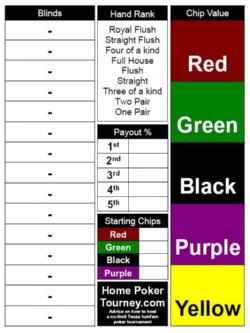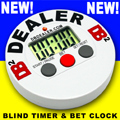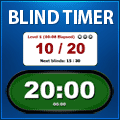|
|
How to Set Up a Poker Blinds Schedule
A typical T1000 blinds schedule for a No-limit Texas Hold'em poker tournament is shown to the right. T1000 means that each player is issued 1000 chips at the start of the tourney. This blinds schedule starts out slow for the first hour and should result in a poker tournament of about 4 hours. You can also use this same schedule for a T1500 tournament, the game will just last a bit longer. This schedule is used throughout this website and is available for download and printing on my Create-a-Blind page. How to calculate a poker tournament blinds schedule
Example: 1000 chip buyin tournament lasting four hours
A typical T10,000 blinds schedule for a No-limit Texas Hold'em poker tournament is shown to the right. T10,000 means that each player is issued 10,000 chips at the start of the tourney. This blinds schedule starts out slow for the first hour and should result in a poker tournament of about 4 hours. This schedule is available for download and printing on my Create-a-Blind page. This schedule is set up using the same method as the schedule shown above. This tournament should end when the big blind equals the buyin (10,000). The chips needed for your tournament depends on the blinds schedule that you use. For example, with the T1000 blinds schedule shown above, 1000 starting chips should be issued in something like a 20/16/5 format (20xT5, 16xT25, 5xT100). If you want to use standard casino poker chip colors, you would issue 20 red chips, 16 green chips and 5 black chips to each player at the start of the tournament. See my Chips Needed page for more information about how many poker chips you need to run a poker tournament. Predicting when your poker tournament will end is far from an exact science. You will have to play several tournaments with your friends before you get a true feeling for how long your games will last. Some wild games could end quite quickly with several players busting out immediately after the rebuy period but if you play in a rock garden (tight players) your games will probably last longer than anticipated. The speed of your dealers and the length of time each player contemplates his betting decision will also have a great influence on the length of your game.
Please take note that the above formulas are an over-simplification of a very complex calculation. It is almost impossible to absolutely guarantee exactly when your tourney will end. Experience, knowing your players, and duplicating previously used poker blinds structures are your best allies. Smaller tournaments (less than 8 or 10 players) could finish much sooner than anticipated. Mid-size tourneys (10 - 20 players) should follow the above formulas. Larger tournaments (more than 30 players) are a completely different story ... it is best to use one of the Foxwoods schedules and expect your tournament to last 5 to 6 hours. The starting big blind (the first hand dealt) should be approximately 1/50 to 1/25 of the initial buyin. For example, if the buyin is 1000 chips, the first big blind should be anywhere from 20 to 40 chips. Another way to express this is to say that there should be anywhere from a 50:1 to 25:1 ratio of starting chips to the first big blind. You can make this ratio as high as 100:1 but if your starting blinds are too low - your tourney might take a very long time to complete or you might be forced to increase your blinds too quickly towards the end. After determining what the starting and finishing poker blinds should be, simply plug in all the levels in between. You want the blinds to gradually increase from your starting blind to your anticipated finishing blind, then continue past for a couple more levels just to be on the safe side. Each big blind should be about twice as large as the previous big blind. It can be less, but should not be more. The small blind is usually one-half (10/20), or two-thirds (10/15), of the big blind. Remember that you might be coloring-up your chips throughout the night (see Chip Color-up). Keep your blinds amounts relative to the chip denominations that will still be in play at that particular time. For example, take a look at the blinds schedule above ... what would happen if you changed the 800-1600 level to a 750-1500 level? It doesn't seem to be a problem until you realize that the Green (25) chips might have been removed from the table two hours ago. How can you possibly bet 750 if you have no chips less than your Black (100) chips? You should probably keep the blinds on the low side for the beginning levels of a home tourney. Many players will have little experience and it is best to start them off slowly but ... do not turn your tourney into a crapshoot! You do not want hours of low, meaningless blinds and then have the blinds increase very drastically towards the end of the tourney. Ensure that you have a gradual progression of the blinds. You want the most skillful player to win, not the player who received the luckiest cards on the last five hands! Most poker tournaments use 15, 20, 30, 45 or 60 minute blinds levels. Ten or twelve minute levels may be fine for online tournaments but are much too fast for a home game where the play is much slower. Blinds levels of 20, 30, or 45 minutes seem best for a home tournament. Sixty minute levels seem a bit too long and drawn out. Ready to try your luck online after mastering your home poker tournaments? We can show you the online poker sites as well as the best casino games at the top online casinos. It may be necessary to adjust your poker blinds schedule during the tournament. If you are six hours into your seven hour tourney and no player has busted out yet (and the wife will be home in two hours!) you will have to drastically increase your blinds to force an end to the game. Try to avoid waiting until the final blinds levels before making any necessary adjustments. It is much better to start making slight adjustments during the middle/late levels than to make huge adjustments during the final levels. On the other hand, don't be too quick to make any adjustments at all. Altering your posted blinds schedule should only be done in extreme circumstances. Many players (especially those remaining towards the end of the game) would prefer to play an extra 2 or 3 hours than make any adjustments. It is easy to guarantee a definite end time for your tourney. If you absolutely must be out of your rented hall by midnight, simply announce on your tourney flyer, and post on the walls in plain view, that "This tournament will end at 11:45pm. If there is more than one player remaining in the tournament at that time; any hands presently in play will be completed and the purse will then be awarded according to the chip count.". Make sure you also include how you will handle ties. I do not use antes as I find that the blinds come around the table quick enough to force the play of hands. You might consider adding antes if you play with many players at each table, especially if those players tend to play slowly. You might also consider antes towards the end of your tourney to speed things up. Rebuys will play a role in the length of your tourney. The longer the length of the rebuy period - the longer the length of your tourney. Add-ons (buying additional chips during the tourney) will greatly increase the length of time it takes to end your tourney. Allowing rebuys and add-ons will also have the effect of loosening up the play in your game. Players will play riskier if they know that they can reach into their pocket to buy more chips after they bust out. See the Buyin/Payout page for more information on rebuys and add-ons. No-limit hold'em is the most popular type of poker and, according to Poker30.net, has the largest tournament payouts. Players can find plenty of online no-limit hold'em games on sites such as PokerStars.net and PartyPoker.net. There are a lot of different variations of holdem tournaments including multi-table re-buy tournaments and one-table sit and go tournaments - for more information on these poker variations as well as poker strategies, you should visit PlaySolidPoker. There are a lot of different sites to play poker, but the best poker site, hands down, is PokerStars because they have more players than all the other poker sites combined.
|
||||||||||||||||||||||||||||||||||||||||||||||||||||||||||||||||||||||||||||||||||||||||||||||||||||||||||||
Online Poker Guide
Hand Converter
Holdem strategy
Freeroll tournaments
Poker calculator
Online poker
Poker rooms
> poker pokeren
> iDeal poker
> online casino
> iDeal casino
> casino casinos
> casino bonus
Get Bonus code Titan Poker, and full tilt poker referral code or max bonus to the full tilt referral code. Best ultimate bet referral code sign up bonus doyles room promo code or poker host bonus code
























